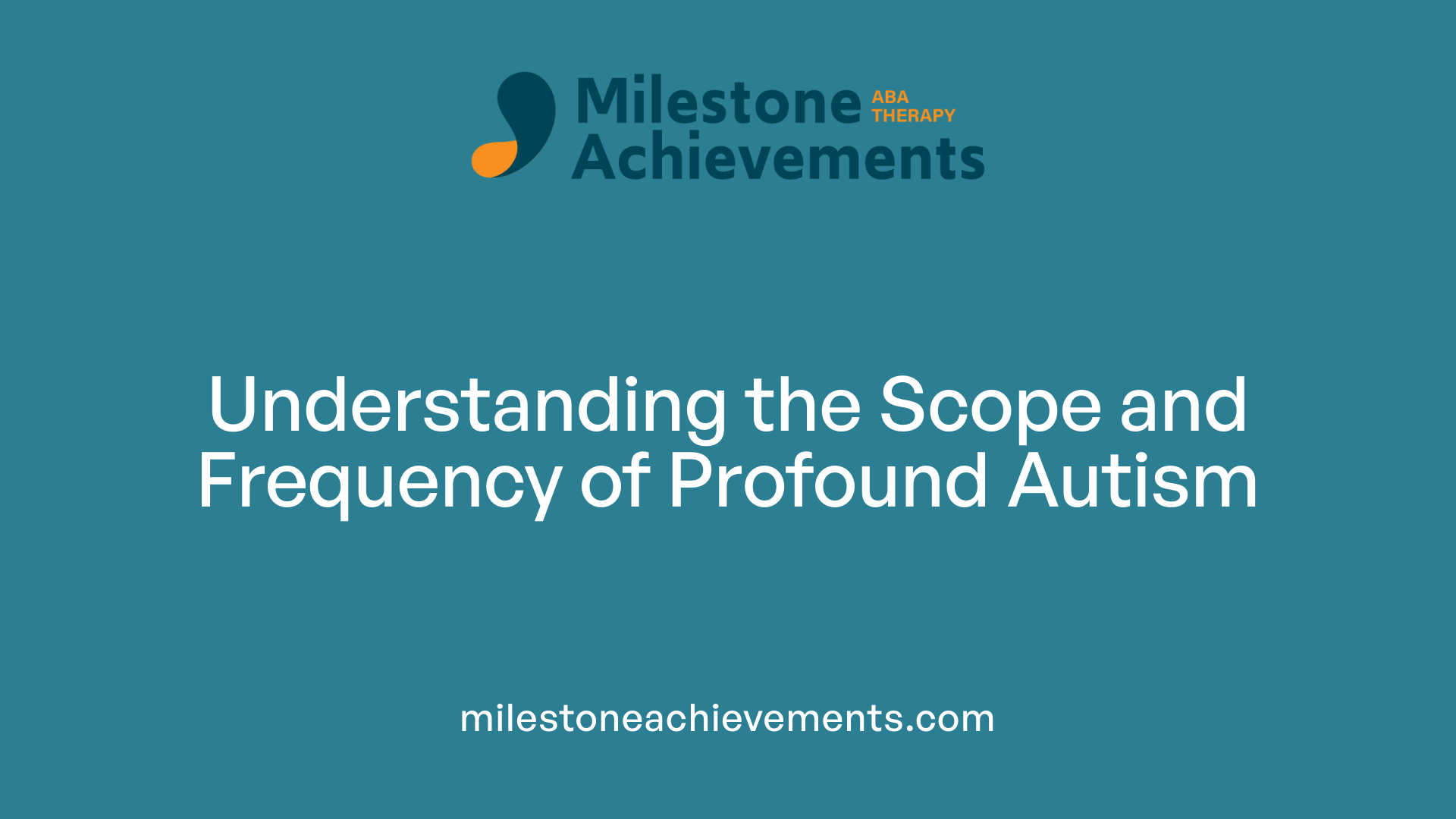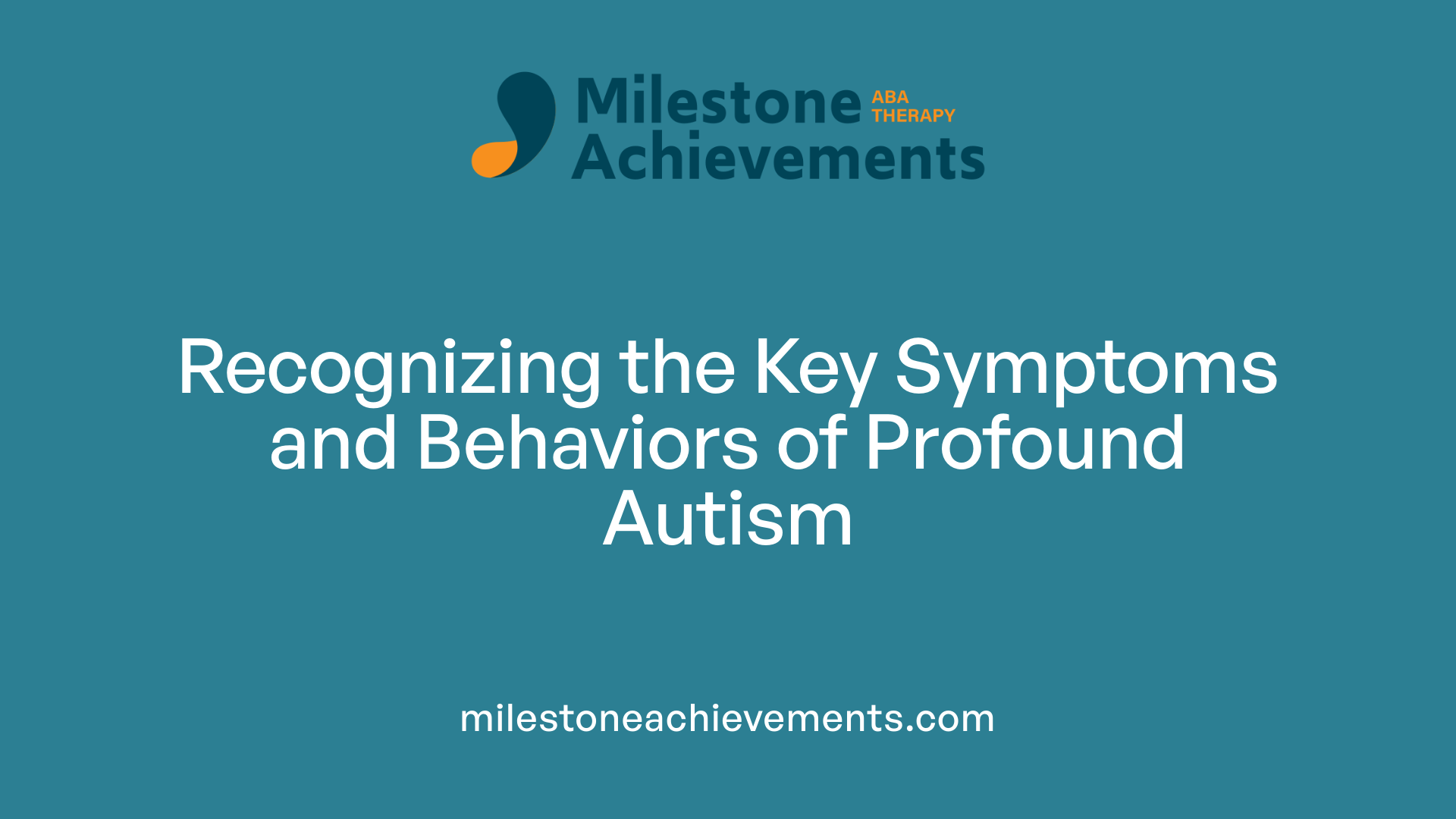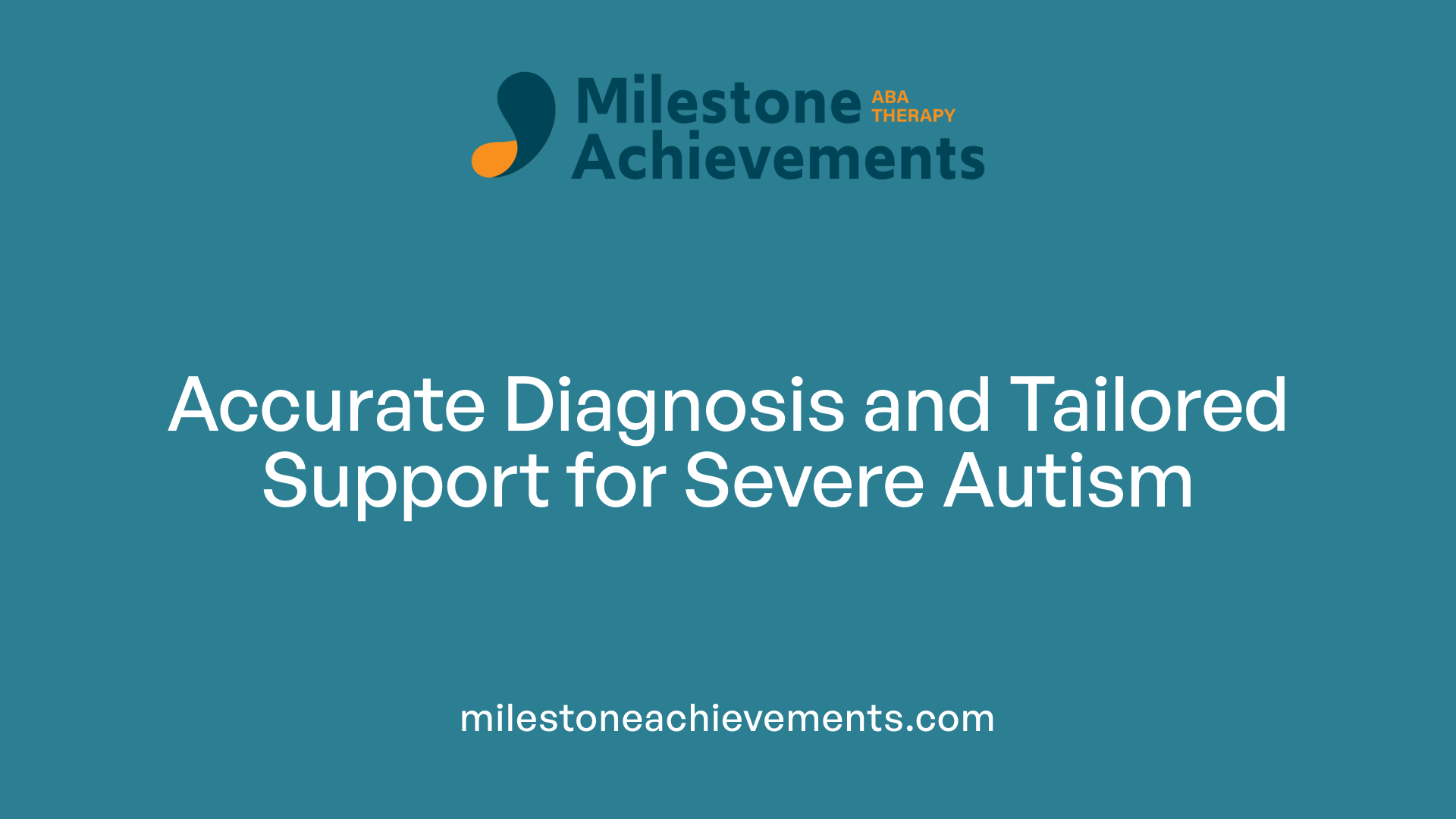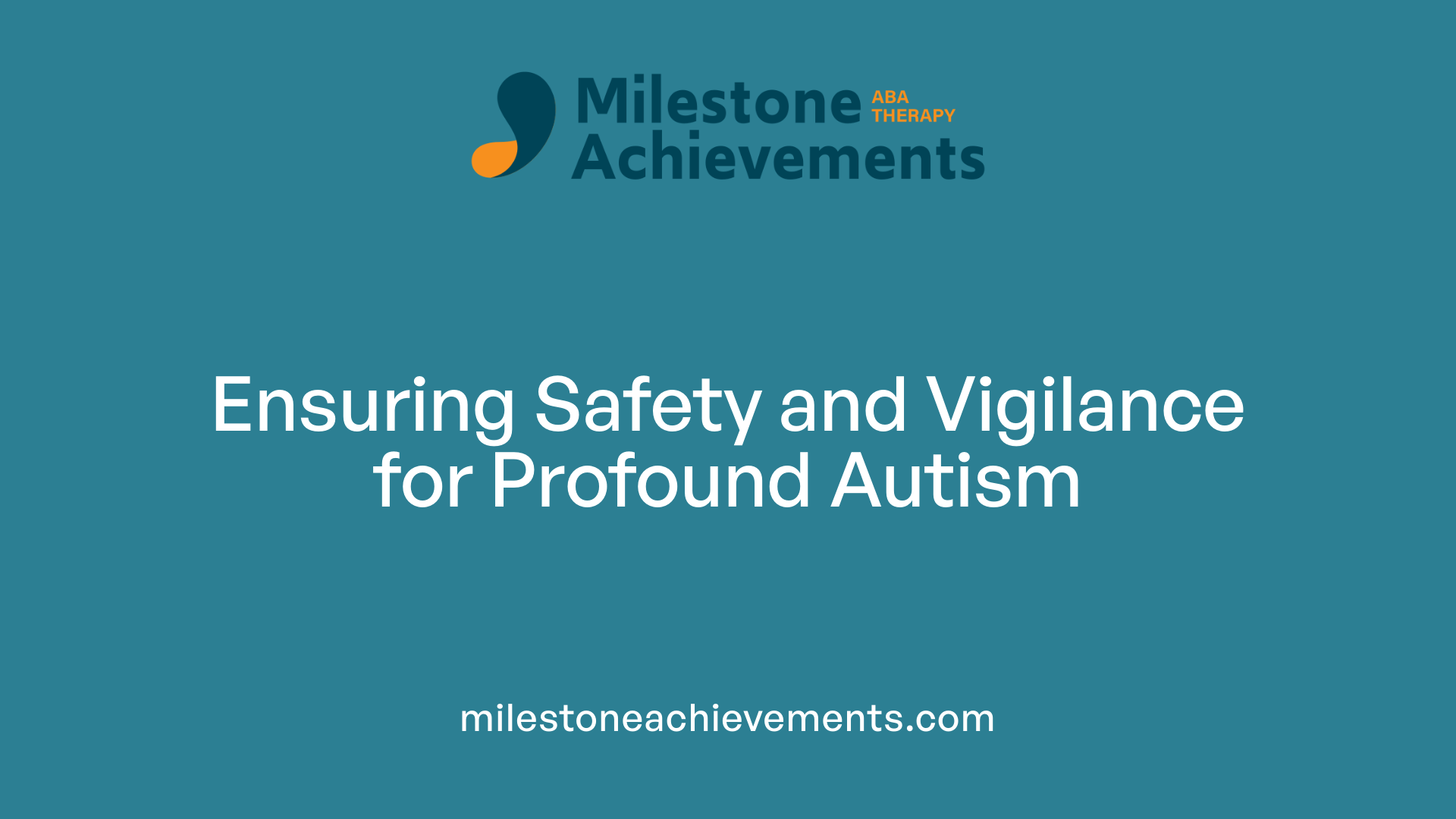
Symptoms of Profound Autism
Understanding the Deep Challenges in Autism Spectrum Disorder
Exploring the Core Aspects of Profound Autism
Profound autism is a subset within the broader autism spectrum that signifies severe impairments in communication, cognition, and daily functioning. Characterized by significant clinical support needs, it impacts individuals' ability to interact socially, communicate effectively, and perform basic daily activities independently. Recognizing the diverse symptoms and challenges associated with profound autism is essential for developing effective care, support strategies, and policies aimed at improving quality of life for these individuals.
Defining Profound Autism and Its Prevalence

What is profound autism?
Profound autism represents a subset of individuals on the autism spectrum who have very high support needs. It is characterized by an IQ below 50, being nonverbal or having extremely limited speech, and requiring assistance with daily tasks such as dressing, bathing, and eating. These individuals often face severe cognitive and communication impairments, and many necessitate lifelong, intensive supervision.
Many with profound autism experience medical issues like epilepsy and exhibit behaviors such as self-injury and aggression, which pose safety concerns. Due to their significant challenges, they typically need 24-hour care and support in all aspects of daily life.
How common is profound autism among children?
Research shows that approximately 26.7% of children with autism, particularly at age 8, meet criteria for profound autism. This translates roughly to about one-quarter of children on the autism spectrum, making it a significant subgroup. The prevalence tends to be higher among girls, children from racial or ethnic minorities, and those from low-income families.
How does profound autism differ from other levels?
Unlike individuals with less severe autism who might communicate verbally or engage in social interactions more readily, those classified as profoundly autistic have profound limitations in language, social skills, and cognition.
FeatureProfound AutismOther Autism LevelsAdditional DetailsIQ RangeLess than 50Varies, generally higherBelow 70 indicates significant impairmentVerbal SkillsMinimal or noneOften verbal or with limited speechMany are nonverbalSupport NeedsExtensive, lifelong supportModerate to mild supportBased on daily life and safety needsTypical BehaviorSeizures, self-injury, aggressionLess severe behavioral issuesHigher likelihood of medical complicationsIndependenceRequires total assistanceVaries, some can be more independentAbility to perform daily tasksUnderstanding profound autism is essential for developing tailored interventions and for resource planning. Recognizing its unique features ensures that these individuals receive appropriate care, support, and inclusion in research efforts.
Core Symptoms and Behavioral Indicators

What are the signs and symptoms of profound autism?
Profound autism is characterized by severe difficulties across multiple areas including communication, social interaction, and behavior. Individuals with this level often show minimal or no verbal communication abilities. They may not respond to their names, avoid eye contact, and display limited reactions to social cues, making social interactions challenging or impossible.
Communication impairments are prominent; many are nonverbal or have extremely limited vocabularies. They rely heavily on alternative methods such as picture exchange systems or electronic devices to communicate basic needs or preferences.
Social interaction also proves to be very limited. These individuals typically withdraw from social activities and struggle to initiate or sustain social contact. They may show little interest in engaging with others or understanding social norms.
Repetitive behaviors are common and often intense. These include hand-flapping, rocking, spinning objects, or repeating words and phrases (echolalia). Such behaviors are often pronounced and resistant to redirection.
Medical and behavioral issues frequently accompany profound autism. Many individuals have co-occurring conditions like epilepsy, self-injurious actions, and severe tantrums. They often demonstrate regression of skills, such as losing previously acquired language or self-care abilities.
In addition to behavioral symptoms, people with profound autism usually require 24-hour supervision and extensive support with daily activities, including dressing, eating, and hygiene. They may also have significant intellectual disabilities, with IQ scores below 50.
Overall, the signs of profound autism include high support needs, difficulty communication and socialization, frequent repetitive behaviors, and medical challenges. Recognizing these symptoms is vital for providing appropriate care, early intervention, and specialized support tailored to their complex needs.
Communication Challenges and Support Strategies

What are the features related to communication challenges in profound autism?
Individuals with profound autism face significant obstacles in both verbal and non-verbal communication. Many are nonverbal or have very limited speech capabilities, which makes expressing needs, feelings, or thoughts difficult. They might rely on alternative forms such as picture exchange systems, electronic devices, or gestures, which require specialized training to use effectively.
These individuals often struggle to understand or interpret social cues like facial expressions, tone of voice, or body language. This impairs their ability to engage in typical social exchanges, such as initiating conversations or sharing interests. Consequently, social interactions can be minimal or absent, leading to social isolation.
Repetitive behaviors such as echolalia, where they repeat words or phrases, are common but can further complicate communication. Their understanding of language may be impaired, making it hard to follow commands or grasp complex instructions.
Support strategies for profound autism emphasize the importance of personalized communication methods. Speech therapy often incorporates augmentative and alternative communication (AAC) devices, which are tailored to the individual's needs. Visual supports like picture schedules or signs can help clarify routines and expectations.
In addition to communication tools, sensory integration therapies are often used to improve engagement and reduce anxiety linked to sensory sensitivities. Overall, addressing communication challenges in profound autism involves a comprehensive, multidisciplinary approach designed to foster understanding, interaction, and independence.
Severity and Behavioral Manifestations

What are the severity levels and associated behaviors in profound autism?
Profound autism is a classification within the autism spectrum disorder (ASD) that highlights individuals with the most significant challenges in communication, behavior, and cognitive functioning. These individuals often have an IQ below 50, which indicates severe cognitive impairment, and many are nonverbal or minimally verbal.
People with profound autism typically require continuous, intensive support in daily activities such as dressing, bathing, and preparing meals. They need lifelong supervision, often around the clock, to ensure their safety and basic needs are met.
Behaviorally, profound autism presents with a range of severe symptoms. Commonly observed behaviors include self-injury, aggression, and intense repetitive actions like rocking, hand-flapping, or spinning. These repetitive behaviors, coupled with severe communication deficits, can make social interactions challenging or impossible.
Sensory sensitivities are prominent, with many individuals experiencing heightened reactions to sounds, lights, or textures. These sensitivities can be debilitating, sometimes leading to meltdowns, which are intense episodes involving crying, screaming, or physical outbursts.
This severity level also involves behaviors triggered by overload or stimuli, such as autistic meltdowns or tantrums, which may result from difficulty in managing environmental changes or sensory overload.
Overall, profound autism is characterized by a high support needs classification, involving complex behavioral, communication, and sensory challenges that necessitate specialized care and intervention.
Diagnosing Profound Autism and Support Needs

How can profound autism be diagnosed?
Profound autism is not officially recognized as a specific diagnosis in the DSM-5, but it is a proposed classification used to describe individuals within the autism spectrum with severe impairments. Typically, these individuals have an IQ below 50 or are nonverbal or minimally verbal.
Diagnosing profound autism involves evaluating core symptoms such as difficulties with social communication—like limited gestures, facial expressions, or eye contact—and the presence of intense, repetitive behaviors like hand-flapping, rocking, or echolalia. Supports required daily are also assessed, including the need for constant supervision and assistance with basic life skills such as dressing, bathing, and feeding.
Cognitive and language assessments play a vital role. A significantly delayed or absent speech, combined with adaptive skills well below developmental expectations, supports a diagnosis of profound autism.
This classification also considers observable behaviors, medical issues like epilepsy, and sensory sensitivities. The purpose of this approach is to ensure that individuals with the highest support needs are identified and receive appropriate care, interventions, and inclusion in research.
While not an official official diagnostic category in the DSM-5, the concept of profound autism helps clinicians and caregivers better understand the severity of impairment and tailor services accordingly.
Safety, Abuse, and Neglect Concerns
 Individuals with profound autism face heightened safety risks due to their severe communication challenges and cognitive disabilities. Recognizing signs of abuse or neglect in this population requires careful observation because they may not be able to verbalize their discomfort.
Individuals with profound autism face heightened safety risks due to their severe communication challenges and cognitive disabilities. Recognizing signs of abuse or neglect in this population requires careful observation because they may not be able to verbalize their discomfort.
Signs of abuse can include physical indicators such as unexplained bruises, burns, scars, or injuries that appear in unusual or inconsistent locations. Behavioral changes are also notable, with affected individuals possibly exhibiting increased withdrawal, fearfulness, aggression, or regression in skills. Neglect may become evident through poor hygiene, untreated medical issues, or sudden deterioration in overall health.
Because these individuals often cannot express pain or fear directly, caregivers need to be vigilant. Medical and behavioral assessments should be conducted regularly to detect any signs of harm early.
Preventive measures involve education for caregivers about potential risks, establishing safety protocols, and closely monitoring individuals for any signs of abuse or neglect. Creating a trusted environment where caregivers and staff are trained to spot and respond promptly to concerns is essential. Regular safety checks, body scans, and open communication help reduce harm and ensure the well-being of those with profound autism.
To summarize, protecting individuals with profound autism requires awareness of physical and behavioral cues of harm, proactive safety planning, and fostering a supportive, vigilant caregiving environment.
Educational Challenges and Future Directions

What challenges are faced educationally by individuals with profound autism?
Individuals with profound autism encounter a wide array of educational obstacles that stem from their neurological and developmental profiles. Many have significant difficulty processing information, understanding social cues, and engaging in communication, which are vital for effective learning and social participation.
Sensory sensitivities—such as hypersensitivity to sounds, lights, or textures—can make classroom environments overwhelming, leading to withdrawal or distress. Additionally, deficits in executive functioning often impair their ability to plan, follow routines, or switch tasks, complicating daily learning routines.
Many students with profound autism require highly individualized supports that acknowledge their unique needs. The lack of specialized training among educators and limited availability of tailored resources further diminish opportunities for meaningful educational engagement. Standard testing and assessment methods often fall short in capturing their true abilities, resulting in underestimations of their potential.
Behavioral challenges like self-injury, aggression, or extreme meltdowns can also interfere with learning, necessitating behavior management strategies that are part of a broader support plan. Overall, these layered challenges highlight a critical demand for comprehensive, personalized educational approaches that foster skill development and promote inclusion.
Support strategies
To effectively support students with profound autism, a multifaceted approach is essential. Implementing sensory-friendly classroom modifications, such as quiet zones or adjustable lighting, can help mitigate sensory overloads.
Developing individualized education programs (IEPs) that specify tailored goals for communication, daily living skills, and social interaction is crucial. These should incorporate assistive technologies like communication devices or picture exchange systems to facilitate expression.
Training educators in autism-specific interventions ensures that teaching methods are evidence-based and sensitive to behavioral cues. Family engagement and collaboration with therapists, behavior analysts, and medical professionals further augment support networks.
Routine use of visual schedules, social stories, and structured routines can improve predictability and reduce anxiety. Staff should also be trained to recognize early signs of distress or triggers for behavioral episodes.
Research and policy considerations
Ongoing research aims to refine support strategies and understand the diverse presentations of profound autism. Deepening knowledge about sensory processing, neurodevelopmental pathways, and effective intervention models will inform better educational practices.
Policy reforms are needed to increase funding for specialized programs, train educators adequately, and promote inclusive environments. Establishing national and local standards for the education of profoundly autistic individuals can ensure consistency and quality.
Promoting awareness and reducing stigma are vital for fostering acceptance and facilitating community integration. Advocacy efforts should also focus on improving data collection on profoundly autistic populations to guide targeted research and allocate resources appropriately.
AspectFocus AreaDescriptionChallengesProcessing & CommunicationDifficulties in understanding social cues and expressing needsSupport strategiesEnvironmental AdaptationsSensory modifications and assistive communication toolsPolicy developmentResource AllocationFunding and standards for specialized autism educationAdvancing education for individuals with profound autism remains a complex challenge that calls for collaborative efforts in research, policy, and practice, ensuring all individuals receive the support necessary to thrive.
Causes and Controversies in Profound Autism Research

What is known about the causes of profound autism?
The origins of profound autism are complex and involve both genetic and environmental components. Research has identified over 100 risk genes associated with the condition, and twin studies consistently support a strong genetic influence, suggesting that up to 90% of autism cases may be inherited.
Environmental factors during pregnancy also play a role in increasing the likelihood of developing profound autism. These include parental ages, exposure to harmful substances or toxins, maternal infections during pregnancy, and certain medications taken by the mother.
The increasing prevalence of profound autism in recent years has raised questions about the influence of improved diagnostic criteria and greater awareness. It’s believed that these factors, combined with genuine increases in cases, contribute to the observed rise.
However, despite advances, the precise biological and environmental mechanisms underlying profound autism remain elusive. Ongoing research aims to better understand how genetic predispositions interact with prenatal environmental influences, ultimately affecting early brain development and leading to severe autism symptoms.
FactorsDescriptionAdditional NotesGeneticOver 100 risk genes identified, high heritabilityTwin studies show a 90% genetic contributionEnvironmentalToxins, maternal health, infections, medicationsPrenatal exposure affects fetal brain developmentDiagnostic TrendsBroader criteria, increased awarenessContributes to rising prevalence figuresUnknownsExact biological mechanismsResearch continues to explore gene-environment interactionsUnderstanding the causes of profound autism is essential for developing targeted therapies and support systems, although much remains to be discovered about its origins.
Ensuring Support and Awareness for Individuals with Profound Autism
Recognizing and understanding the profound symptoms of autism is vital for providing appropriate support, safeguarding well-being, and promoting inclusion. Comprehensive care tailored to individual needs can significantly improve quality of life, ensuring that those with profound autism are respected, supported, and integrated into society. Continued research, policy development, and community awareness are essential for addressing their unique challenges and fostering a more inclusive environment.
References
- Symptoms Of Severe Autism In Children & Adolescents
- What Is Profound Autism? - Child Mind Institute
- Profound autism: Definition, characteristics, and support
- Recognizing signs of abuse in profound autism
- What is Severe Autism? Symptoms, Behaviour, and Levels
- Profound Autism: An Imperative Diagnosis - PubMed
- Understanding Severe Autism (Level 3) and Its Impact on Daily Life
- Profound Autism - National Autism Center at May Institute


Partner with us on your child's journey
Milestone Achievements offers evidence-based ABA therapy to help children with autism reach their full potential. Together we’ll set meaningful goals and celebrate progress every step of the way.
Start ABA Services Today


